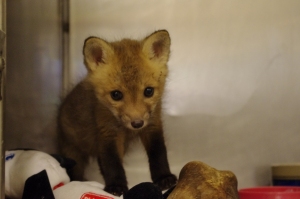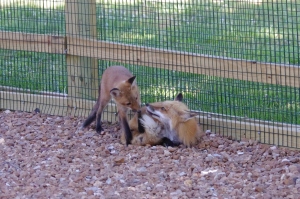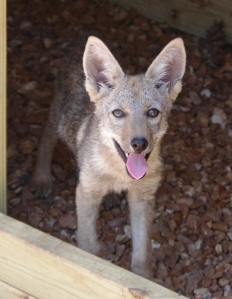It’s almost a rite of passage for an intern or volunteer at TreeHouse to answer the phone one day in the spring and find him- or herself attempting to dissuade someone who is clearly planning to make a pet out of the young animal they have just found in their backyard. It might be a litter of squirrels; it might be a raccoon; it might even be an opossum or a clutch of ducklings. Whatever the species, it’s with a sinking stomach that we begin our conversations with these well-meaning animal lovers who call for advice about what they should feed their new pets.

It can be difficult to convince people that the Beanie Baby-esque red fox kit will not make a good pet.
We politely inform them that it is against Illinois state law to remove any animal from the wild for the purpose of keeping it as a pet, and then we go on to talk to them about some of the many reasons this law exists. Wild animals have specific nutritional requirements that can be difficult for a private individual to meet. If the animal requires medical attention, few vets have the training, experience, and licensing required in order to treat wild animals. Wild animals can carry and transmit a variety of diseases, and vaccines developed for use in domestic animals may be ineffective in wild animals. But above all, for all the reasons I discussed in Part I of this article, wild animals simply do not make good pets. A person who takes in a raccoon may be enough of an “animal person” to overlook a set of shredded curtains and a few broken knick-knacks, but that raccoon is not a “human animal,” so to speak. Wild animals do not want to live with humans, and they’re not suited to do so—the absolute best someone could realistically hope for is for their wild pet to form a close bond with a handful of people and behave in a misguidedly defensive manner toward anyone else.
In my experience, the most difficult “pets” to talk anyone out of are foxes and coyotes. It goes back to those dichotomous views on carnivores—some people will shoot a fox on sight, and others dream of having a pet fox that will scamper around their feet in the kitchen and then curl up in a ray of sunshine on the back of the couch. Yes, foxes are indescribably adorable when they’re young, and coyote pups look and act pretty much like any other kind of puppy. It’s easy to look at them and imagine what fun it would be to cuddle them and play with them, and then when they grow up to have this close relationship with a wild creature.
In general, the people who find young foxes and coyotes and decide to keep and raise them want, above all, to do what is best for that animal. The problem is that in many cases, by the time they are convinced that what is best for the animal is not for it to live as a pet, irreversible damage has already been done. Social animals form social bonds easily when they are young. Wild animals do not bond with humans as readily as domestic animals do, but if a member of their own species is not present, young animals will latch onto a human for companionship. When this happens, we consider the animal “human-socialized”. A human-socialized fox or coyote may be very playful and affectionate when it is young, but when it grows up an array of problems are likely to arise.
First, health problems result from inadequate nutrition or exercise. Then, training does not “take” the way it does in domestic dogs—a domestic dog will often perform merely for praise and the satisfaction of pleasing its master, but while a wild animal may know exactly what its trainer wants from it, there is nothing that will convince it to obey if it sees a better reward in doing something else. The final straw for many people keeping wild canids as pets is often tragic—the yapping of the neighbor’s Chihuahua or even the squealing of a small child that has tripped on the stairs can be enough to trigger a wild carnivore’s prey response.

Chuckles is our red fox foster mother. She helps orphaned kits grow up wild enough to be able to return to the wild.
It is often after either a string of problems or a single major episode that the person in possession of the fox or coyote finds him- or herself facing a difficult choice. Pet shelters will not accept wild animals, sanctuaries are nearly always full to capacity, and, of course, possession of the animal was illegal to begin with. So the choice is one between putting the animal down and releasing it back into wild. Usually, those who have kept foxes and coyotes as pets choose the second option when they can no longer keep the animal, thinking that their erstwhile companion will go on to have a fulfilling life in the wild, but in reality this second option is hardly different from the first.
A wild animal, once human-socialized, will have little hesitation in approaching humans again. It has learned to see humans as a source of food, and if it has difficulty obtaining food in the wild (which is likely, given that it never had the opportunity to learn from its parents how to hunt), it will readily approach trash cans and pet food dishes, and even approach humans directly, looking for a hand-out. But because of the fear and hatred that many humans feel toward these animals, the hapless fox or coyote is likely to be run off, shot at, poisoned, or even killed by a larger domestic dog. One way or another, the life of a human-socialized carnivore in the wild will be a short one.
Within just a couple of weeks, or even much less, depending on the age and personality of the animal, a young fox or coyote can become human-socialized to the point that it will never be able to survive in the wild. At TreeHouse, we receive semi-socialized foxes and coyotes nearly every spring. Sometimes, someone who finds an orphaned kit or pup does not know about TreeHouse at first, but brings the animal to us as soon as they can. Other times, the person who finds the young animal does not realize the importance of avoiding all human-socialization, or they think that raising the animal themselves for a short time will have no negative impact.
When this happens, our priority becomes a sort of psychological rehabilitation. The young foxes and coyotes are placed with other young of their own species when possible, and as soon as they are eating solid food they are placed outside to bond with and learn from a foster parent. Sometimes it works, and the animals are able to return to the wild when they are grown. But not always.

Trickster, just a few months old when this picture was taken, is a permanent resident of TreeHouse because of his human socialization.
Neither of our permanent resident coyotes at TreeHouse have any physical problems precluding them from going into the wild: they were both human-socialized as pups. We give them the best life we can at TreeHouse—they have each other’s companionship, and they receive regular enrichment, but they will forever be caged in a sort of limbo—animals that were born wild but raised by humans, too fearful to be really comfortable in human company, but too bold to survive an encounter with humans in the wild. And that is why we hope every year that this will be the last time we admit an animal too human-socialized for release.
Leave a comment